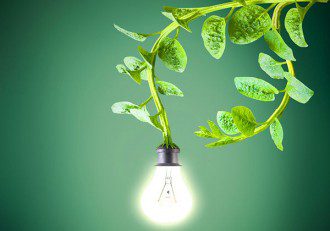Contributing Writer for Wake Up World
Could living plants be the future of electricity? If the folks at Plant-e have anything to say about it, the answer is a resounding YES. To prove their point, a project dubbed “Starry Sky” illuminated 300 LED lights in Hembrug, Netherlands — exclusively powered by living plants. Similar to another project about an hour’s drive away, both installations are the first two public applications of the budding technology.
But plant-powered lighting isn’t the only area the company has explored, Wi-Fi hotspots, mobile chargers and rooftop electricity modules are also available. And large-scale tubular systems for commercial use are in the works.
[pro_ad_display_adzone id=”110028″]
The Ultimate Green Energy
While the idea of photosynthesis to generate energy isn’t necessarily new — remember engineering clocks made from potatoes in middle school? — Plant-e’s technology is the first to harness power from plants without harming them. Marjolein Helder, Plant-e’s cofounder and CEO, believes the advancements achieved by their company are nothing short of revolutionary.
Both light projects that brightened the Dutch night used native aquatic plants that were grown in modules connected to each other. By utilizing the process of photosynthesis, Plant-e has found a way to generate electricity, as explained by Yes! Magazine:
1. Photosynthesis
When the sun shines, leaves of plants absorb light and combine its energy with carbon dioxide and water to make sugar. The plant uses this sugar as food.
2. Plant Waste
Not all of the sugar produced through photosynthesis is used by the plant. The extra — which is about half of the sugar made— is excreted into the soil through the roots.
3. Breakdown
Bacteria in the soil then break down these sugars. In this process, protons and electrons are produced.
4. Electrodes
Plant-e places a carbon conductor into the soil, where bacteria donates an electron. Electrons that were made as the sugars broke down then flow into the electrode.
5. Extraction
These electrons are transferred to a power harvester.
6. Electricity
The energy gathered can then be used to charge your cell phone.
The idea to employ photosynthesis for energy production was first discovered by Dr. ir. Bert Hamelers and the feasibility of the technology was subsequently published in the journal Environmental Science & Technology. From 2009 to 2012, new areas of science were explored in the development of the plant-microbial fuel cells. As a result, Plant-e was born.
Next Steps
According to the company, once the system is optimized, it could produce up to 3.2 W/m2 — or 2800 kWh/year for every 100 square meters of growing plants. For a typical energy-hogging household in the United States, at least 4,000 square feet of space would be required to generate 10,837 kWh/year. But a standard Dutch home only uses around 3500 kWh a year, so a Plant-e system could generate up to 80% of their household energy needs. The results are even more impressive as you move closer to the equator because of higher solar radiation levels. However, the opposite is also true — the technology doesn’t work when the ground is frozen. Similar to solar and wind energy, the energy yield of plants depend on the climate.
The modules can be used on any flat surface — a rooftop, roundabout or park — to power LED lights, cellphones and other low voltage gadgets. A district in Zeist, Netherlands is currently utilizing the Plant-e system to power a Wi-Fi hotspot.
The company has also created a DIY-box for practical lessons in primary and secondary schools. Additionally, a square meter Plant-e raised bed is available for limited spaces where vegetables and herbs generate power for small devices. Larger applications for increased electrical yield would utilize plants already present, such as existing wetlands. A tube is placed horizontally below the surface of a peat bog, mangrove, rice paddy or river delta and employs the same conversion method as the modular system.
“Modular systems are interesting, but you can only scale up to a certain size because it’s pretty labor- and material-intensive,” Helder said in Yes! Magazine. “A tubular system can just be rolled out through the field and it just works because the plants are already there. So for the longer term, for the really large scale, that’s much more interesting.”
Plant-e developed a prototype tubular system in 2013, but needs to secure funding to launch a pilot program. Helder said the company hopes to have a commercial product available in about two more years.
Plant-e Animation
Article sources:
- http://www.plantpower.eu
- http://www.yesmagazine.org/planet/dutch-company-powers-streetlights-with-living-plants-will-your-cellphone-be-next
- http://pubs.acs.org/doi/abs/10.1021/es071938w
- http://revolution-green.com/plant-e-plants-generating-electricity/
Previous articles by Carolanne Wright:
- Monsanto Charged with Crimes Against Nature and Humanity – Set to Stand Trial in 2016
- Considering the Flu Shot? Here are Five Reasons to Think Twice
- Dr Sebi: The Man Who Cures Aids, Cancer, Diabetes and More
- Plastic-Eating Mushroom Discovered in the Amazon Rainforest — A Solution for Our Trash Saturated World?
- Chronic Lyme Disease: A Modern Plague the Government Chooses to Ignore
- Big Pharma and Organized Crime — They are More Similar Than You May Think
- Over 100 Scientific Studies Agree: Cannabis Annihilates Cancer
- Emotional Energetic Healing: The Future of Medicine is Here
- Why Every Parent Should Consider Unschooling
- The Greenhouse of the Future: Grow Your Own Food Year-Round With This Revolutionary System
- First U.S. City Produces More Electricity Than It Uses — With 100% Renewable Technology
- Autistic Boy with Higher IQ Than Einstein Discovers Gift After Removal from State-Run Therapy
[pro_ad_display_adzone id=”110025″]
[pro_ad_display_adzone id=”110027″]







